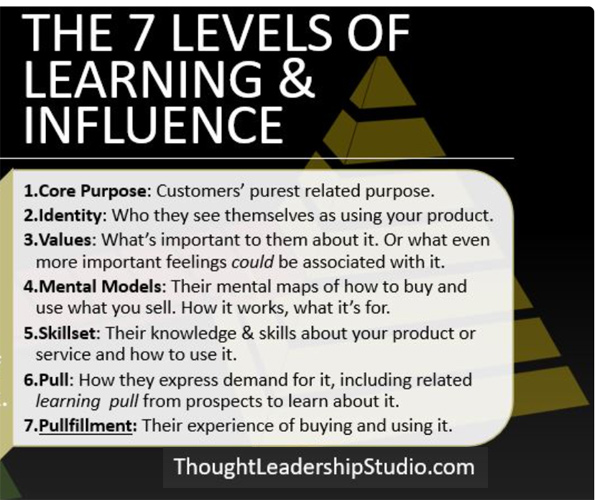Thought Leadership Studio Podcast Episodes:
4 Methods of Multiple Level Communication
Episode Nineteen - Increase your positive influence by adding depth and power to your communication.

#contentmarketing, #contentwriting, #influencermarketing, #nlp, #storytelling, #strategicthoughtleadership, #thoughtleadership, #thoughtleadershipexamples, #workshop
Or Click here to listen or subscribe on appWhat this episode will do for you
- Help you add depth and power to your communication.
- Increase your positive influence.
- Help you close more sales.
- Help your clients' or audience's changes stick long term.
- Get more impact and deeper engagement from your content.
Solving a Dilemma for a Client: His Clients' Changes Weren't Sticking.
I recently started working with a client who leads a team that consults with businesses. I'm going to keep who he is and the details of his work confidential, but, in general they work with management teams to bring about a more positive, productive culture in their respective businesses.
He told me they get great results initially, but their clients seem to eventually "snap back" to their old habits as if tethered to a bungee cord.
 He also had been talking to various marketing agencies to increase his company's audience but he told me he told them that he couldn't see how they could write content that represented them well when these agency writers weren't experts in his field.
He also had been talking to various marketing agencies to increase his company's audience but he told me he told them that he couldn't see how they could write content that represented them well when these agency writers weren't experts in his field.
He said he saw my work and recognized that the problem was he and his associates were leading and teaching clients only on a logical level. The clients were receiving them well on that level. The problem was that wasn't changing their clients' deeply rooted beliefs. And those limiting beliefs weren't aligned with a positive culture.
So these clients would slip back to familiar ground eventually, with their culture slipping back with them.
He said he now realized he needed to impact their belief systems so the changes would last.
I told him that we can do that. We can identify widespread toxic beliefs, and design paths of belief change, from old beliefs to new beliefs. I am now helping him restructure how his consultancy communicates so they are keeping the current and compelling conscious-mind oriented principles but now adding a whole additional layer.
By recognizing and using the structure of language, they are leading his clients to new beliefs.
He says he is already seeing a difference and getting more "aha" moments with clients by helping them not only embrace principles and practices but expand their world view to a completely new perspective. They now have the eyes to see a fundamental new way of looking at their businesses.
And we are also utilizing this multiple level communication in media to make a positive impact on his marketplace as a whole. This enables creating a concentric circles model of lead generation that includes leading a greater audience to these more empowering beliefs.
The process of designing content using a compelling back-story of thought leadership means the outside support for content is different. The ideas are emerging and getting well organized through our work together. There are still roles for outside writers. But, the tasks are shifting to editing for clarity, creating a flow of ideas to impactful organization and outputting them in the right media at the right times. This means the right prospects see the content, get intrigued, and engage more deeply.
It's a thought leadership campaign that is leading a growing audience to new and helpful thinking.
And when this audience needs further help in bringing these changes more deeply into their organizations, my client's team becomes the natural go-to. It's a persuasive, organic lead generation strategy.
So, when there is a belief system that isn't in alignment with the change you are aiming for, working on it from a logical, conscious level is like trying to make a business-to-business sale to a clerk. That clerk may agree with your idea but doesn't have the authority to make the decision. That kind of decision is made at a higher level in the business' hierarchy.
As I told the client, "Similarly, long-term positive change is made at a higher level of thinking and if you don't influence at that level, the change won't happen in the long run. So influence on multiple levels."
He did and the changes are happening.
How are we doing this? There's a lot to it but maybe the most critical aspect - and the part this podcast episode addresses - is using multiple level communication.
What This Podcast is for: A Workshop in Strategic Positive Influence
You can consider this podcast an ongoing workshop to help you attain even more peak performance in Strategic Thought Leadership. Think of the episodes as your library for self training as a high performing thought leader.
Condensed Learning
 Keep in mind that with some of these topics I've spent years honing my approach with model building, testing, learning and incorporating principles from breakthrough examples, as well as various other ways of innovating and optimizing. My intention is to bring this learning down to a condensed form for your optimum empowerment.
Keep in mind that with some of these topics I've spent years honing my approach with model building, testing, learning and incorporating principles from breakthrough examples, as well as various other ways of innovating and optimizing. My intention is to bring this learning down to a condensed form for your optimum empowerment.
So I strongly recommend repeated listening as well as keeping in mind the multiple level learning that is both the topic of this particular episode and, as I will explain, can happen (to at least some extent) outside of conscious awareness.
"Ha!" I can hear some of you perhaps thinking, "Nice trick. If you get us to believe we are making breakthroughs in our communication skills and confidence on an unconscious level, you'll gain listeners and clients without really teaching anything."
I'd reply to any such hypothetical listeners that they are right ... in the sense that having an impact on beliefs is actually a higher level of influence - with accompanying greater positive impact - than the typical conscious-mind learning, like remembering a list of "right things to do".
But, sure, I'll concede that it is helpful to simultaneously engage the conscious mind with a list of "right things to do." That's coming up ...
And that through my training in Neuro-Linguistic Programming (NLP), I'm using techniques like multiple level learning, embedded metaphorical loops, and accelerated learning - both to - Give you an accelerated training process on this never-ending continuum of being better at strategic positive influence, and also to
- Act as a model to follow - in how I convey these skills - in order to assist you in putting these to work in your own communication.
4 Methods of Multiple Level Communication
- Separating Conscious and Unconscious Communication.
- Using Embedded Metaphorical Stories.
- Using Language Patterns of Belief Change.
- State Change.
Multiple-Level Influence Method One: Separating Conscious and Unconscious Communication
 One method of multiple level communication is communicating with both the unconscious mind and the conscious mind simultaneously with two separate "tracks".
One method of multiple level communication is communicating with both the unconscious mind and the conscious mind simultaneously with two separate "tracks".
But what is this mysterious "unconscious mind"?
Consider that the greater portion of our learning is outside the directed attention we refer to as the "conscious mind". You may have heard or read somewhere that we can only consciously hold just five +/- two bits of information at a given time.
It's like the limited working memory (or RAM) of a computer compared with massive hard drives that carry much more information.
Or you can think of the unconscious mind like the background programs that are always running on a computer. They are out of sight and out of mind, but they keep the computer you're using operating. You don't consciously notice them as you run a program on the screen of your computer. But your computer won't run without them taking care of those "background tasks".
Similarly, the unconscious mind takes care of background tasks like your heart beating, your lungs breathing, and the individual motor movements necessary for walking that you don't have to think about as you're doing it.
Similarly, as you gain motor skills in things like driving a car, they move from the foreground of your conscious mind to the background of your unconscious mind. And, that is necessary since the conscious mind needs to be more free to pay attention to things like avoiding pedestrians who unconsciously walk in front of your car as they trance out looking ever more deeply into the 4 inch screens of their smart phones.
 And there are methods like embedded metaphor where the conscious mind is kept a little distracted by a story where it gets engaged in the content of the story, but it's the structure of the backstory and how it engages the unconscious mind.
And there are methods like embedded metaphor where the conscious mind is kept a little distracted by a story where it gets engaged in the content of the story, but it's the structure of the backstory and how it engages the unconscious mind.
And I remember hearing that Erickson, the father of modern hypnotherapy, said that the conscious and unconscious minds are like the rider and the horse. The rider is not going to get the horse to go anywhere it really doesn't want to go. So you have to get your unconscious mind wanting to go to the places where you can get your audiences' unconscious minds wanting to go if you want to have true influence. Like the horse to the rider, it's not going to go if it doesn't want to.
So sometimes learning happens entirely outside conscious awareness. By example, just by being exposed to the method, you start to pick up on it. Just like how kids being exposed to the behavior of adults start to emulate it automatically. Kids are more naturally in that learning state of play, of enjoyment, of having fun, where you are a sponge modeling behaviors around you without realizing it.
Multiple-Level Influence Method Two: Embedded Metaphorical Stories.
You are likely already well aware of using metaphorical stories to influence powerfully yet indirectly. But are you yet aware of the power of "stacking" such stories? Multiple, stacked embedded metaphorical stories are sometimes called "nested loops". It is about nesting stories within stories.
You're telling a story and you break it off before it gets to the end by diving into another story within the story.
Suppose there's a story about somebody's walking down the street and running into an obstacle they need to overcome. But as they're starting to do that, they see a show in a retail store's window on TV of someone else overcoming a related obstacle within that obstacle. The subject of the initial story stops to watch that show for a while. As the actor or actress on TV succeeds at whatever it is that is analogous to the point you are making, that story sinks in And then the subject of the "level one story" carries on in their journey.
You can keep going further layers deep. Richard Bandler, one of the co-developers of neuro-linguistic programming, is a master of this embedded loops method.
It becomes easy to consciously forget the stories within stories and only remember the outermost story. Bandler would go as many as five levels deep. He taught using your fingers to track how many levels deep you are as you tell such stories within stories.
Now you don't have to get that good at it to get great benefits. Really just one level is often enough. But learning to track a story behind story while telling stories about people who are facing the kinds of challenges that you're leading your audience through is quite powerful. It can create the kind of shifts in thinking we want for our thought leadership models.
It's indirect suggestion. And that is more powerful than direct suggestion because you're bypassing listeners' conscious resistance since it is about someone else or something else, yet they still absorb the information.
Multiple-Level Influence Method Three: Using Language Patterns of Belief Change.
 This is a very deep subject and one we bring to life in our thought leadership projects. This could also be called "higher level influence" because, as per the 7 Levels of Learning and Influence Model, beliefs (AKA Mental Models) are a higher level than knowledge (which is part of the Skillset level).
This is a very deep subject and one we bring to life in our thought leadership projects. This could also be called "higher level influence" because, as per the 7 Levels of Learning and Influence Model, beliefs (AKA Mental Models) are a higher level than knowledge (which is part of the Skillset level).
And influence flows down from higher levels to lower levels.
In short, a belief connects 2 things in that it can always be stated as an if-then statement, even if that isn't apparent on the surface. Also, the definition of a belief is that we act on it as if it is true.
Related Content
In Strategic Thought Leadership, Marketing, Leadership, and Influence we aren't usually dealing with the deeply rooted beliefs we might call convictions. The most leveraged beliefs often have to do with how people perceive our product, service, field or profession:
- What its purpose is.
- What its role is in our lives.
- What the important attributes are.
- What are the relevant criteria in a buying decision.
.The assumptions people hold are usually pretty moldable when they can see that the fresh perspective of a better mental model is to their benefit.
And then you have the beginnings of creating a true, robust Thought Leadership Model. The Thought Leadership Model has 9 components but lets consider three especially relevant ones here:
- Audience Baseline Position: their old mental model, or their old assumptions you are leading them away from.
- The Thought Leadership Position: the new mental model or belief you are leading them to.
- The Support Points or persuasive talking points that lead them from A to B.
These Support Points build a library of helpful positions that undermine the old thinking and support the new thinking. We build them with our clients using language patterns of persuasion that influence on an unconscious level.
Multiple-Level Influence Method Four: State Change
Elicit a helpful state of mind and put it where it makes a positive difference.
Sometimes we aren't so much trying to give an audience something to consciously remember as we are helping them attach a different feeling to something. In NLP we call this state elicitation and anchoring.
State Path
Know the feeling you are guiding them from and the new, better feeling you are guiding them to. NLP offers ways to both accurately describe and access these states. Strongly anchor powerful, positive feelings to your "Thought Leadership Position" to help create motivation for that bright, gleaming positive future you are leading your audience to. To clarify, you help your prospects, followers, viewers, or readers feel great about where you are taking them. If I was going to do something like that with this post, I might ask the reader to imagine the joy of the benefits of doubling the magnetism of their communication, then doubling it again.
***************************************
Free Stuff and Offers Mentioned in Podcast
***************************************